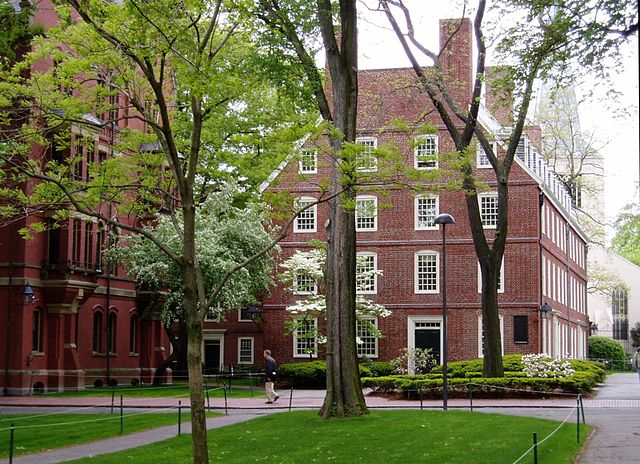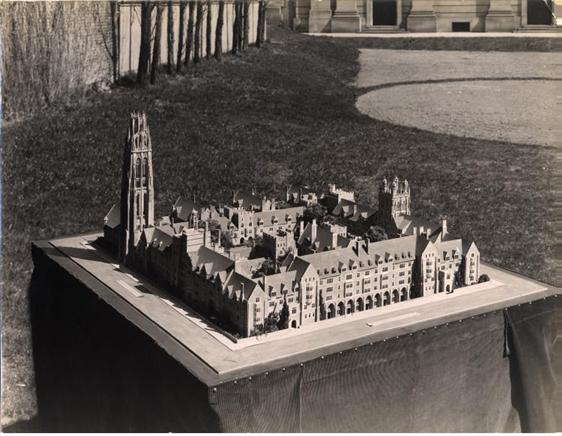Hotels have received plenty of architectural attention, but unless you’re Howard Hughes or Coco Chanel you probably haven’t spent four years living in them. One space where most readers have likely spent just that long in residence – and that hasn’t attracted a fraction of that kind of attention — is the old-fashioned college dormitory, now ably addressed in Carla Yanni’sLiving on Campus: An Architectural History of the American Dormitory.
The dormitory is an interesting space, intrinsically transient but often designed to serve as a social aggregator, edifying home environment and cocoon from baleful influences, once loose morals and religious nonconformists,lately Halloween costumesand Republicans. It’s a building type represented virtually everywhere in the United States — Yanni notes early on that there are likely more than thirty thousand dormitory buildings in the U.S.
The first unusual thing about American dormitories is simply how widespread they are. You don’t actually need to house students on-site: this happens for a very small minority of students in secondary and boarding schools, and a minority in graduate education. Living on campus is not remotely as common in a number of other societies, and wasn’t the standard even in some European societies that provided inspiration to American universities. A prime task is to explain“why Americans have believed for so long that college students should live in purpose-built structures that we now take for granted: dormitories. This was never inevitable, nor was it even necessary. ”

Massachusetts Hall at Harvard University, the country’s oldest dormitory (1722)
The religious and often rural origins of many American colleges, designed to remove students from the malignant influences of the city, played a prominent role in the provision of housing. She quotes Nathaniel Hawthorne’sFanshaweand its fictional Harley College— “The local situation of the college, so far secluded from the sight and sound of the busy world, is peculiarly favorable to the moral, if not the literary, habits of its students; and this advantage probably caused the founders to overlook the inconveniences that were inseparably connected with it. ”
It’s easy to roll one’s eyes about broader recent claims about housing always being an ideological project, but in the case of universities it was and always has been one, concerning “the socially constructed nature of the student ”—With the (partial) exceptions occurring in the postwar period, when students were treated less like charges to be bent to one’s will and more like cattle. Even then, questions emerged: is it social engineering to separate genders or engineering to combine them? I simply don’t know.
Harvard and William and Mary featured student residences from their earliest days, often intermingled with virtually all university functions in the same buildings. Residence halls were a feature of most early colleges, but a fair number of universities dispensed with them. State universities located in towns of any size frequently looked upon dormitories as an extravagance and students entirely capable of renting lodging elsewhere. The first dormitory at Rutgers was only built in 1890. The University of Wisconsin at Madison had some housing but then eliminated it for decades.
Boardinghouses almost always existed on the outskirts of universities, but were generally viewed as fertile ground for immorality or even literal disease, and campus residences a better means of shaping the moral and educational lives of their students— which is all true to some extent. The sheer number of moral concerns affecting the lives of students receded as time went on, although stances on these questions have never gone away, and have risen again in prominence in the age of institutional social-justice claptrap.
The notion of cultivating a seamless educational environment no doubt has considerable value. A University of Wisconsin pamphlet advertised new dormitories as “designed to bring into the life of every undergraduate the cultural inspiration and force of the university.”
One chapter addresses the rise of fraternities. These were at times welcome as self-supporting institutions promoting some version of civic responsibility, at other times a source of concern as charnels of affluent drunkards whose vortex of vice distracted many more than members from their studies. Their highflying economic character often prompted colleges to respond with more explicitly egalitarian efforts. The University of Wisconsin characterized its own building effort in leveling tone, “Here, too, the man from the well-to-do house and the man who tends furnaces to buy his text-books will learn respect for each other across a common table . ”
There were limits, of course, with dorms frequently being segregated or otherwise limited, obviously barring women but an assortment of faiths and minorities. One casually rancid comment on the topic from a University of Michigan dormitory donor: “I don’t see why the orientals are there. That building is not the League of Nations. ”
Yanni devotes ample attention to the literal arrangement of residential halls, with the most common being either double-loaded corridors or vertically-oriented stairway plans. The former are obviously simple, the latter more common in fancier confines. Female residential halls often took on the corridor format which enabled easier monitoring, while also generally featuring more social space: when visitation between sexes was permitted it was far more common that males could attend social events at female dorms, with the hopeful result being a transmission of some domestic calm. Her focus shifts between exemplars and averages in this book, but touches upon a large amount of excellent residential work, from an Ann Arbor fraternity house designed by Albert Kahn to numerous superb residential halls.

Model of Memorial Quadrangle at Yale University, by James Gamble Rogers ( Wikimedia Commons)
James Gamble Rogers ’sublime Yale residential colleges are treated in detail, as landmarks in their own right, but also as avatars of a broader trend aping Oxbridge residential colleges both in their concept and quadrangular form. Yanni notes that the 1930 s-era “scale of building Yale’s residential colleges is almost unimaginable in the context of university planning today. It would be like designing, constructing, furnishing, and opening for business several enormous five-star hotels, all in the space of two years. ”Some universities built very respectable residences on smaller budgets, but this points to another pressing dilemma. Fantastic dormitories make sense for the wealthiest of American colleges, while for many others they are a huge extravagance.
One far-less-than-satisfactory solution of skyscraper dormitories, beginning after World War II and explosion of enrollment under the G.I. Bill, which mar a considerable number of universities. Sometimes these are simply necessary in urban circumstances, while in other cases they are not remotely: the campus of Ohio State University occupies over 1500 acres; it wasn’t any shortage of space that lead to 26 – story dormitory towers. Rutgers in New Brunswick, N.J. is slightly more constrained, but a series of seven-story housing towers only utilized 18 percent of its plot. They are cheap: she explains that once an expensive elevator bank was installed there was generally no reason not to pile on a few or a dozen more floors. Such large-scale construction often frustrated the important aim of forging smaller coherent communities in the midst of large universities, and added another anonymizing element to already anonymously large universities.
Yanni then details the reaction against this facelessness, some of which was objectively silly, some quite meritorious. One guide for planning a new college at Rutgers commented that “every effort must be made to avoid the hotel-like atmosphere so common in large universities today.” (They must have been simply looking across their own campus.) At the same time, a dean suggested that the new residential college would have “a very swinging faculty, an exciting student body, and a real degree of orientation to everyday problems.”

Kresge College at UC Santa Cruz (Wikimedia Commons)
Having students design their own units was not much of a successful idea at the University of California, but efforts at building smaller and more organic residential communities often had many praiseworthy elements. Charles Moore’s Kresge College at the University of California Santa Cruz, modeled on Italian Hill Towns, has many fine aspects. Eero Saarinen’s colleges at Yale may very well not be to your taste compared to Rogers at Yale, but his inspirations were medieval and his design a reaction to the monotony of more recent collegiate architecture. He commented, “we have tried to avoid the sense of standardization which is so prevalent in twentieth century architecture.”
More recently, we reach the rise of luxury dormitories, the Lazy River at the University of North Florida and other fripperies that lead parents to the equivalent of second mortgages — and also the rise of the for- profit University of Phoenix, and learning expedients with no dorms at all. Both are obviously flawed, and there are no easy solutions to college housing. But as college presidents, benefactors, and architects look forward, they might consider the many examples explored by Yanni in the long history of over two centuries of American college dormitories.
Anthony Paletta is a journalist based in New York.






GIPHY App Key not set. Please check settings